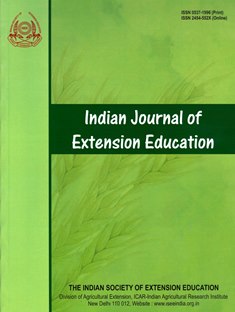A Tool to Measure Livelihood Vulnerability of Climate-Sensitive Farming Communities
DOI:
https://doi.org/10.48165/IJEE.2025.614RT01Keywords:
Livelihood vulnerability, Climate change, IPCC framework, Adaptive capacity, Sensitivity, ExposureAbstract
Climate change is one of the major concerns for rural livelihoods, particularly for families dependent on agriculture. Understanding livelihood vulnerability to climate change is essential for developing adaptive strategies. The present study, conducted in March 2025, aimed to develop a scale for livelihood vulnerability by incorporating three dimensions: exposure, sensitivity, and adaptive capacity. From an initial pool of 53 statements, 36 were finalized after expert validation and statistical screening. The Likert methodology was used to assess the statements. Content validity was established through expert review, and internal consistency of the scale was assessed by using Cronbach’s alpha (0.90), indicating high reliability. The final scale offers a comprehensive, reliable tool for assessing livelihood vulnerability to climate change and can be used for research, policy formulation, and relevant interventions in climate-sensitive regions.
Downloads
References
Ashoka, N., Harshavardhan, M., Hongal, S., Meti, S., Raju, R., Patil, I. G., & Shashidhara, N. (2022). Farmers’ acuity on climate change in the Central Dry Zone of Karnataka. Indian Journal of Extension Education, 58(3), 136–141.
Arulmanikandan, B., Shehrawat, S. P., Malik, S. J., Bhavesh, & Aditya. (2025). A tool to measure farmers’ training needs in drone-based technologies. Indian Journal of Extension Education, 61(2), 96–100. https://doi.org/10.48165/IJEE.2025.612RT01
Chandra, S., Kalyan, G., Chennamadhava, M., & Waris, A. (2024). Development and validation of a farmer’s focused digital literacy scale: A new measurement tool. Indian Journal of Extension Education, 60(1), 111–115. https://doi.org/10.48165/IJEE.2024.601RT1
Cronbach, L. J. (1951). Coefficient alpha and the internal structure of tests. Psychometrika, 16(3), 297–334. https://doi.org/10.1007/BF02310555
Eckstein, D., Künzel, V., & Schafer, L. (2021). The global climate risk index 2021. Germanwatch, Bonn. https://germanwatch.org/sites/default/files/Global%20Climate%20Risk%20Index%202021_2.pdf
Hussain, S., & Hoque, R. R. (2022). Biomonitoring of metallic air pollutants in unique habitations of the Brahmaputra Valley using moss species-Atrichum angustatum: Spatiotemporal deposition patterns and sources. Environmental Science and Pollution Research International, 29, 10617–10634. https://doi.org/10.1007/s11356-021-16153-x
Hussain, S., Hussain, E., Saxena, P., Sharma, A., Thathola, P., & Sonwani, S. (2024). Navigating the impact of climate change in India: A perspective on climate action (SDG13) and sustainable cities and communities (SDG11). Frontiers in Sustainability, 5, 1308684. https://doi.org/10.3389/frsc.2023.1308684
IPCC. (2007). Climate Change 2007: Synthesis Report. Contribution of Working Groups I, II and III to the Fourth AssessmentReport of the Intergovernmental Panel on Climate Change. IPCC, Geneva, Switzerland. https://www.ipcc.ch/site/assets/uploads/2018/02/ar4_syr_full_report.pdf
Krishnan, R., Sanjay, J., Gnanaseelan, C., Mujumdar, M., Kulkarni, A., & Chakraborty, S. (2020). Assessment of climate change over the Indian region: A report of the Ministry of Earth Sciences (MOES), Government of India. Springer Singapore. https://doi.org/10.1007/978-981-15-4327-2
Kumar, A., & Saxena, P. S. (2021). Climate change in South Asia: Impact, adaptation and role of GI science. Geographic Information Science for Land Resource, 1–18. https://doi.org/10.1002/9781119786375.ch1
Kumar, A., & Saxena, S. P. (2024). Farmers’ awareness and perception about climate change in the Indo-Gangetic plain region of India. Indian Journal of Extension Education, 60(4), 101–106. https://doi.org/10.48165/IJEE.2024.60418
Likert, R. A. (1932). A technique for the measurement of attitude. Archives of Psychology, 22(140), 1–55.
Parmesan, C., Morecroft, D. M., Trisurat, Y., & Mezzi, D. (2022). Climate Change 2022: Impacts, Adaptation and Vulnerability. GIEC; IPCC. https://hal.science/hal-03774939v1
Ray, G. L., & Mondal, S. (2011). Research methods in social sciences and extension education. Kalyani Publishers.
Reddy, S. S. G., Keerthy, G. N., Challa, O., Naidu, K. G. L., & Srinivasan. (2023). Assessment of climate change in different regions of Karnataka state. Mausam, 75(2), 333–348. https://doi.org/10.54302/mausam.v75i2.5873
Saxena, P., Shukla, A., & Gupta, A. K. (2022). Extremes in Atmospheric Processes and Phenomenon: Assessment, Impacts and Mitigation. Springer Nature.
Shitu, G. A., Nain, M. S., & Kobba, F. (2018). Development of scale for assessing farmers’ attitude towards precision conservation agricultural practices. Indian Journal of Agricultural Sciences, 88(3), 499–504.
Sonwani, S., Madaan, S., Arora, J., Suryanarayan, S., Rangra, D., & Mongia, N. (2021). Inhalation exposure to atmospheric nanoparticles and its associated impacts on human health: A review. Frontiers in Sustainability, 3, 690444. https://doi.org/10.3389/frsc.2021.690444
Vijayabhinandana, B., Asha, R., & Gowtham Kumar, B. S. N. S. (2022). Adaptation methods practiced by farmers in response to perceived climate change in Andhra Pradesh. Indian Journal of Extension Education, 58(2), 81–85. https://doi.org/10.48165/IJEE.2022.58216
World Meteorological Organization (WMO). (2022). State of the global climate 2022 (WMO-No. 1316). https://library.wmo.int/viewer/66214/download?file=Statement_2022.pdf&type=pdf&navigator=1
Downloads
Published
Issue
Section
License

This work is licensed under a Creative Commons Attribution-NonCommercial-NoDerivatives 4.0 International License.

